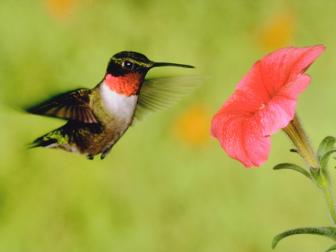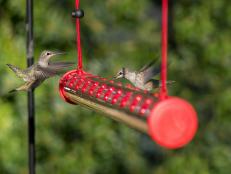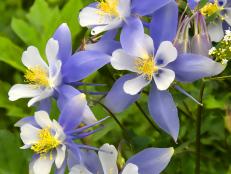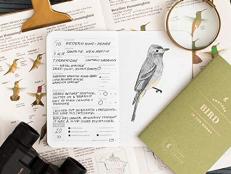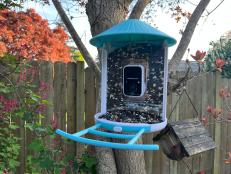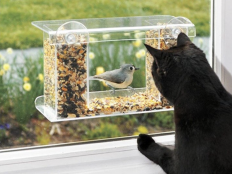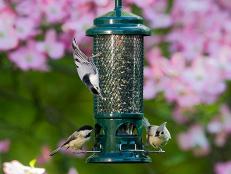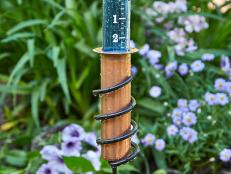Where is the Best Place to Put a Hummingbird Feeder?
Invite energetic hummers to your yard with a nectar-filled feeder.

Image courtesy of Peter Crosson
Swooping, darting and hovering, hummingbirds bring the garden to life. These aerial acrobats flit from flower to flower, sipping nectar each time they dip their beak into a blossom. Hummers must eat every 10 to 15 minutes to survive, which means they visit between 1,000 and 2,000 blossoms per day. Want hummingbirds to hang out longer in your yard? Put up a feeder.
8 Best Hummingbird Feeders + Accessories for Your Yard
Welcome the tiniest of feathered friends with these top-rated feeders and accessories.
Hummingbird feeders are simple to fill and clean, and they provide a perfect place for hummers to perch and sip the sweet nectar they crave. As you consider the best place to put a hummingbird feeder in your yard, keep these tips in mind.
Place the Hummingbird Feeder Near Flowers
One of the best places to put a hummingbird feeder is near plants that hummingbirds are already visiting. Hummingbirds feed from nectar-rich blossoms. They prefer red, yellow and orange flowers with a tubular shape (a long neck with petals on the end). It’s not easy for insects to get the nectar from these types of blooms, which leaves all the sweet nectar for the hummers.
22 Plants to Attract Hummingbirds 22 Photos
Want to appeal to hummingbirds? Hummingbirds are attracted to a wide variety of flowers — usually those that are red and tubular — but to others as well. Consider these flowers they love to visit.
Don't Place in the Heat
Choose a place for your feeder that’s not in direct sun all day. The nectar solution you put into a hummingbird feeder ferments more quickly the longer it’s in the hot sun. If the nectar solution ferments and turns cloudy, hummers will stop once or twice for a sip, but they won’t linger and, if the solution stays funky, won’t return.
Place the Feeder Where You Can See It Easily
Part of the reason to have a hummingbird feeder is to observe these winged wonders. Hummers spend 80 percent of their time perching, so adding a feeder means you’ll get to observe the birds at rest. Try to position your feeder where you’ll be able to see it from indoors. Many gardeners place their hummingbird feeders near indoor eating areas so they can enjoy the air show during mealtimes.
Common Problems With Hummingbird Feeders
- Sun—Too much sun ferments nectar solution, turning it cloudy and rancid.
- Rain—If it rains at the right angle, water can work its way into your feeder portals, diluting the nectar solution. When this happens, hummers will stop visiting the feeder. Your first clue there's a problem will likely be that the nectar solution level doesn’t drop like normal.
- Bugs—Most insect issues can be solved by choosing a feeder with an ant moat (add water plus a few drops of dish soap to trap ants) or small feeding ports designed to exclude bees.
How to Clean a Hummingbird Feeder
Rinse your feeder well with hot water each time you change the nectar solution. At least once a month, give your hummingbird feeder a deep clean. Do not use diluted bleach solution like you typically do with other bird feeders. Instead, clean it with a blend of one part white vinegar to four parts water.
Why Hang a Hummingbird Feeder?
For hummingbirds, constant feeding is a necessity to fuel their pedal-to-the-medal metabolism. Hummers flap their wings 75 times a second (in normal flight), and their hearts beat four times a second. Some hummingbirds undertake long migrations. Ruby-throated hummingbirds fly 550 miles across the Gulf of Mexico, while rufous hummingbirds take a 3,000-mile trek between Alaska and Mexico. The best time of year to hang your hummingbird feeder is during migration. Learn more about hummingbird migration timing at Hummingbirds At Home and Hummingbird Central.
Make Your Own Hummingbird Nectar
Hummingbird nectar is simply sugar water. While you can purchase nectar, it’s not hard to whip up your own. The recipe is simple: four parts hot water to one part white sugar. Do not substitute honey, agave, stevia or other sweeteners for sugar. Heat the water and dissolve the sugar in the water. Do not add red dye to the solution — attract hummers with the color of your feeder, not the color of the food. You can make nectar a quart at a time and store the excess in the fridge for a few weeks. As long as the nectar is clear, it’s good to use. To lengthen the life of nectar, add a product like Nectar Defender, which prolongs freshness.
How to Make Hummingbird Nectar
This easy and inexpensive hummingbird food recipe will have these beloved pollinators making return visits to your garden.









